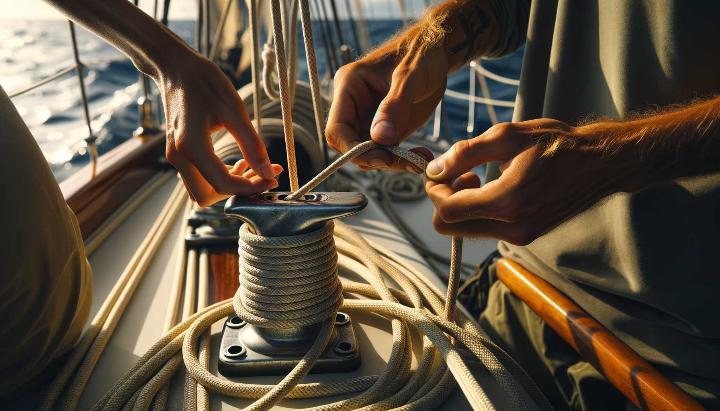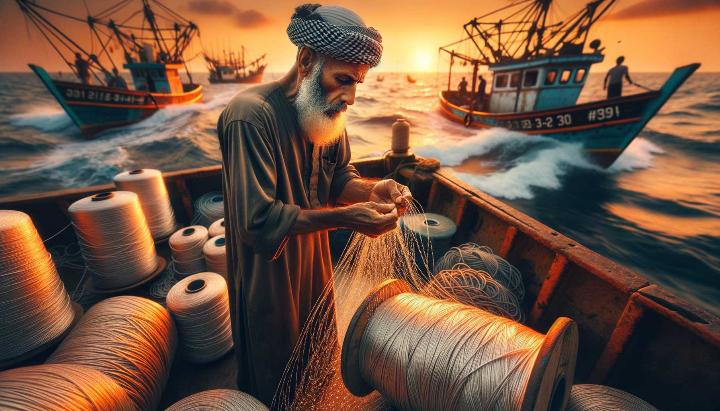Have you ever wondered why some fishing nets seem to last forever while others fall apart after a few uses? The secret lies in the humble nylon seine twine, a crucial component that can make or break your fishing gear. But here's the catch: not all nylon seine twines are created equal. The age-old debate between braided and twisted options has left many anglers and net makers scratching their heads.
As a leading rope manufacturer with 15 years of experience, iRopes has seen firsthand how the right choice of nylon seine twine can dramatically impact fishing success. Whether you're a seasoned fisherman or a budding net maker, understanding the nuances between braided and twisted nylon seine twine is essential for maximising your gear's performance and longevity.
In this comprehensive guide, we'll unravel the mysteries of nylon seine twine, exploring the unique characteristics, advantages, and ideal applications of both braided and twisted varieties. By the end, you'll have the knowledge to make an informed decision that could revolutionise your fishing experience. So, are you ready to dive into the world of nylon seine twine and discover which option will give you the upper hand on your next fishing expedition?
What is Nylon Seine Twine?
Have you ever wondered about the versatile cord that fishermen, builders, and outdoor enthusiasts swear by? Let me introduce you to nylon seine twine, a remarkable utility cord that's been a game-changer in various industries. As someone who's spent countless hours working with different types of cordage, I can tell you that nylon seine twine holds a special place in the world of ropes and twines.
Uses and Applications of Nylon Seine Twine
Nylon seine twine is like the Swiss Army knife of cords. Its versatility never ceases to amaze me. Here are some common applications:
- Fishing industry: Used for trotlines, net repairs, and creating fishing nets.
- Construction: Serves as mason lines for precise brickwork alignment.
- Outdoor activities: Perfect for setting up decoy lines and temporary shelters.
- Gardening: Ideal for trellising and supporting climbing plants.
I remember a time when I was helping a friend set up his vegetable garden. We used nylon seine twine to create a sturdy trellis for his tomato plants. The twine's strength and durability were impressive, easily supporting the weight of the growing plants throughout the season.
Properties and Advantages of Nylon Seine Twine
What makes nylon seine twine stand out from other materials? Let's dive into its unique properties:
Key Advantages
Strength, durability, and resistance to various elements
- Exceptional strength: Nylon seine twine can handle heavy loads without breaking.
- Durability: It resists wear and tear, making it long-lasting.
- Resistance to elements: This twine stands up to abrasion, oil, chemicals, and marine growth.
- Versatility: Available in both twisted and braided forms to suit different needs.
Comparing nylon seine twine to other materials, it's easy to see why it's often the top choice. Its combination of strength and flexibility outperforms many natural fibers, while its resistance to environmental factors gives it an edge over some synthetic alternatives.
Next time you're working on a project that requires a reliable cord, consider nylon seine twine. Its versatility and durability might just make it your new go-to material. Have you used nylon seine twine before? What was your experience like?
Braided Nylon Seine Twine: The Versatile Marine and Construction Essential
As someone who's worked extensively with various types of cordage, I can confidently say that braided nylon seine twine is a true marvel in the world of ropes. Its unique construction and properties make it an indispensable tool for both marine and construction applications. Let me take you through the fascinating world of this versatile twine.
Types and Sizes of Braided Nylon Seine Twine
When I first started working with braided nylon seine twine, I was amazed by the variety of options available. Here's a quick rundown of what you can expect:
- Size variations: Commonly available in #18, #30, and #36, each suited for different load-bearing needs.
- Colour options: From classic white to vibrant hues, colours serve both aesthetic and functional purposes.
- Braided vs. twisted: While both have their merits, braided twine offers superior strength and flexibility.
I remember a project where we needed a strong, yet flexible line for a complex rigging system. The #30 braided nylon seine twine was our saviour, providing the perfect balance of strength and maneuverability.

Applications and Benefits of Nylon Seine Twine
The versatility of braided nylon seine twine never ceases to amaze me. Here are some key applications and benefits:
- Fishing industry: Ideal for trotlines and netting due to its high tensile strength and resistance to marine growth.
- Construction: Perfect for temporary structural support and alignment in various building projects.
- DIY projects: From crafting to home repairs, its durability makes it a go-to choice for enthusiasts.
- Environmental resilience: Stands up to UV rays, moisture, and chemicals, ensuring longevity in harsh conditions.
Have you ever considered using braided nylon seine twine for your projects? Its combination of strength, flexibility, and durability might just be the solution you've been looking for.
In my experience, the key to getting the most out of braided nylon seine twine is understanding its unique properties and choosing the right size and type for your specific needs. Whether you're a professional in the marine or construction industry or a DIY enthusiast, this versatile twine is sure to become an essential tool in your kit.
Twisted Nylon Seine Twine: A Versatile Tool for Various Industries
As someone who's worked with countless types of cordage over the years, I can confidently say that twisted nylon seine twine is a true workhorse in the world of ropes. Its unique construction and properties make it an invaluable asset across multiple industries. Let's dive into the fascinating world of this versatile twine and explore why it's become such a popular choice.
Understanding Nylon Seine Twine Sizes and Types
When I first started working with twisted nylon seine twine, I was amazed by the variety of options available. Here's a quick rundown of what you can expect:
- Size variations: Commonly available in #18, #24, #30, and #36, each suited for different load-bearing needs.
- Colour options: From classic white to vibrant hues, colours serve both aesthetic and functional purposes.
- Treatment options: Tarred or untreated, depending on the specific application and environment.
I remember a project where we needed a strong, yet flexible line for a complex marine application. The #30 twisted nylon seine twine was our saviour, providing the perfect balance of strength and maneuverability in the harsh saltwater environment.

Applications and Benefits of Twisted Nylon Seine Twine
The versatility of twisted nylon seine twine never ceases to amaze me. Here are some key applications and benefits:
- Fishing industry: Ideal for trotlines, decoy lines, and net repairs due to its high tensile strength and resistance to marine growth.
- Construction: Perfect for mason lines, ensuring precise brickwork alignment in various building projects.
- Outdoor activities: From camping to crafting, its durability makes it a go-to choice for enthusiasts.
- Environmental resilience: Stands up to UV rays, moisture, and chemicals, ensuring longevity in harsh conditions.
One of the standout features of twisted nylon seine twine is its superior knot-holding ability compared to braided varieties. This makes it particularly useful in applications where secure fastenings are crucial. I've used it in countless DIY projects, from creating garden trellises to rigging temporary shelters, and it's never let me down.
Key Advantages
Durability, abrasion resistance, and excellent knot-holding ability
Comparing twisted nylon seine twine to braided options, I've found that the twisted construction offers better abrasion resistance and UV protection. This makes it particularly well-suited for outdoor applications where exposure to the elements is a concern. To further enhance your projects with ropes that offer a perfect blend of strength and functionality, explore iRopes' collection of white nylon and polyester cords.
Have you ever used twisted nylon seine twine in your projects? Its combination of strength, flexibility, and durability might just be the solution you've been looking for. Whether you're a professional in the marine or construction industry or a DIY enthusiast, this versatile twine is sure to become an essential tool in your kit.
Choosing Between Braided and Twisted Nylon Seine Twine
As a seasoned rope specialist, I've seen countless fishermen and net makers grapple with the decision between braided and twisted nylon seine twine. It's not just about personal preference; the choice can significantly impact the performance and longevity of your fishing gear. Let's dive into the key factors you should consider when making this crucial decision.
Characteristics of Braided Nylon Seine Twine
Braided nylon seine twine has some unique properties that make it a favourite among many fishermen. Here's what you need to know:
- Superior strength-to-diameter ratio: Braided twine packs more strength into a thinner line, allowing for larger nets with less bulk.
- Excellent flexibility: The braided construction allows for smooth handling and easy knot tying, crucial for efficient net making and repairs.
- Resistance to kinking: This property helps maintain the net's shape and prevents tangles during deployment and retrieval.
I remember a particular fishing trip where the braided nylon seine twine really shone. We were dealing with particularly rough waters, and the net's flexibility allowed it to move with the waves without compromising its integrity. It was a game-changer in those challenging conditions.

Advantages of Twisted Nylon Seine Twine
On the other hand, twisted nylon seine twine has its own set of benefits that make it indispensable in certain situations:
- Greater stretch capacity: This allows the twine to absorb sudden shocks, which can be crucial when dealing with large or particularly active catches.
- Excellent knot strength: The twisted construction provides superior grip, ensuring that knots stay secure even under heavy loads.
- Easier splicing: For those who prefer to splice rather than knot, twisted twine is generally easier to work with.
- Cost-effectiveness: Typically, twisted nylon seine twine is more budget-friendly than its braided counterpart.
I've seen twisted nylon seine twine excel in situations where nets are subjected to sudden, strong pulls. The stretch helps prevent breakages, which can mean the difference between a successful haul and a lost catch. For more insights on how to maximize your rope's performance, delve into strong splice knot techniques with synthetic ropes.
Key Consideration
Your choice between braided and twisted nylon seine twine should be based on your specific fishing conditions and technique.
When it comes to making your choice, consider the type of fishing you're doing, the conditions you'll be facing, and your budget. For instance, if you're dealing with larger fish or rougher waters, the shock absorption of twisted twine might be your best bet. On the other hand, if you need a thinner, more flexible line for intricate net designs, braided twine could be the way to go.
Remember, there's no one-size-fits-all solution. The best choice depends on your unique needs and circumstances. Have you used both types of nylon seine twine? What has your experience been? I'd love to hear about it in the comments below.
At iRopes, we understand the nuances of each type of twine and can help you make the best choice for your specific needs. With our 15 years of experience and a wide range of high-quality cordage options, we're here to ensure you get the perfect nylon seine twine for your fishing success. Explore more on how our expertise in rope and cord techniques can elevate your projects.
```htmlChoosing between braided nylon seine twine and twisted nylon seine twine involves understanding their distinct advantages in various applications. Braided options offer superior strength and flexibility, making them ideal for intricate nets and challenging environments, while twisted nylon seine twine excels in shock absorption and knot strength, beneficial for rugged applications and tight budgets. With a deep expertise in crafting high-quality synthetic ropes, iRopes guides you in selecting the right nylon seine twine to meet your unique needs across fishing, construction, and more.
Uncover the Perfect Nylon Seine Twine for Your Needs
With the inquiry form located above, discover customised solutions and expert advice from iRopes to enhance your rope projects. We invite you to share your requirements so we can help you choose the best-suited nylon seine twine for your applications.
```